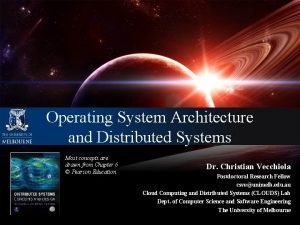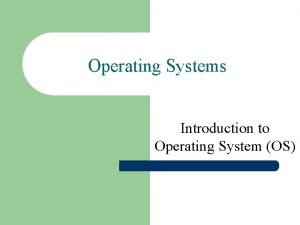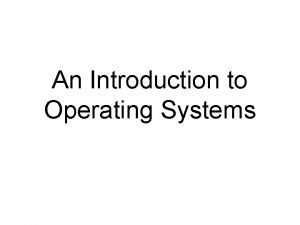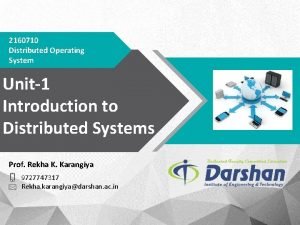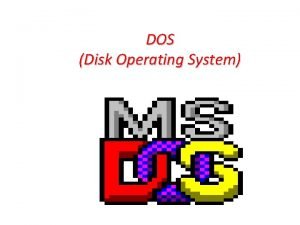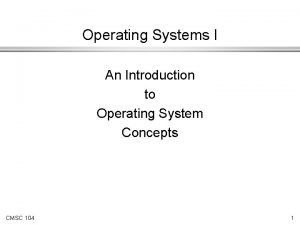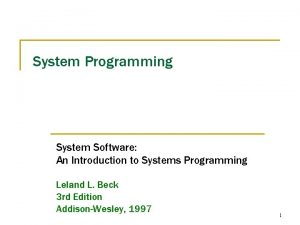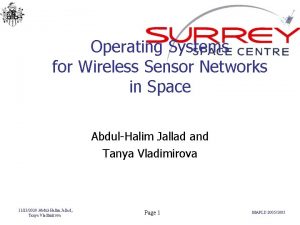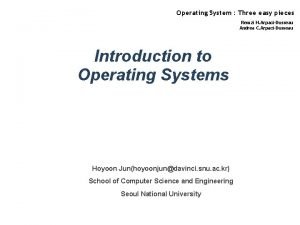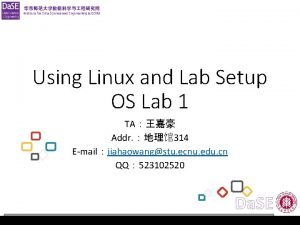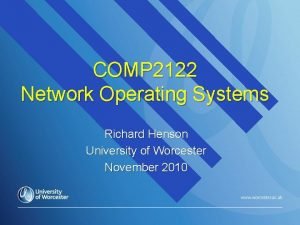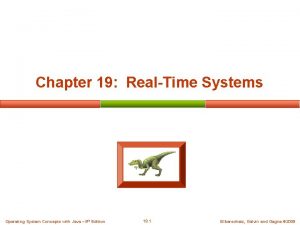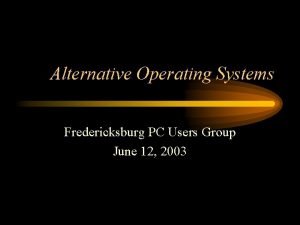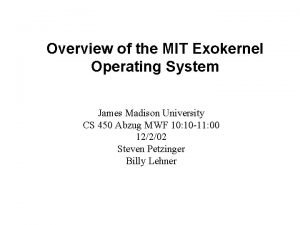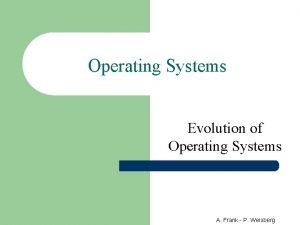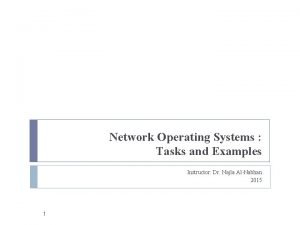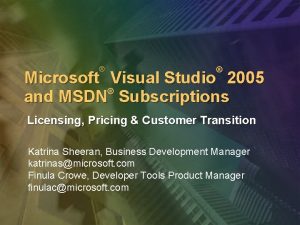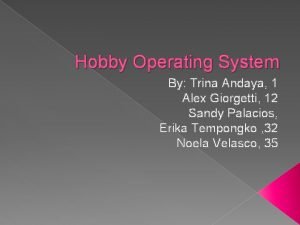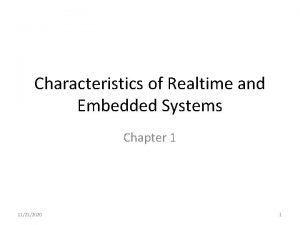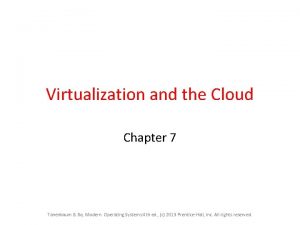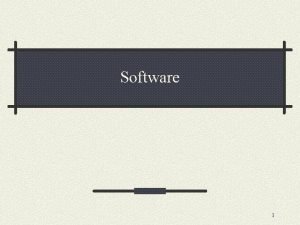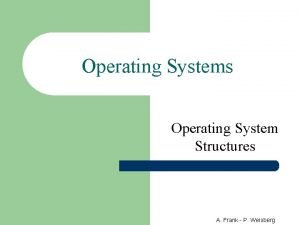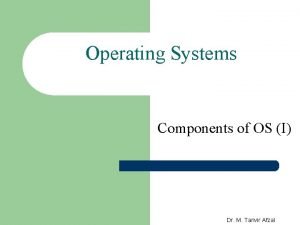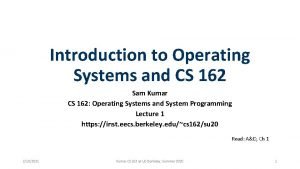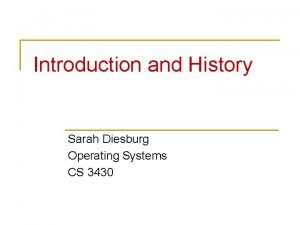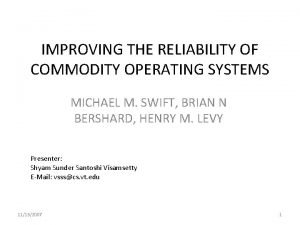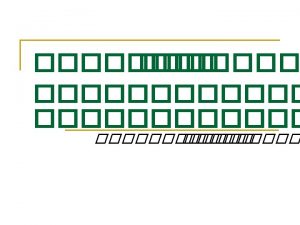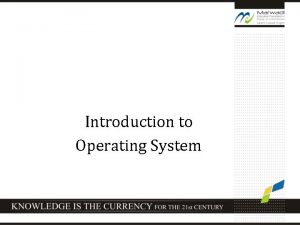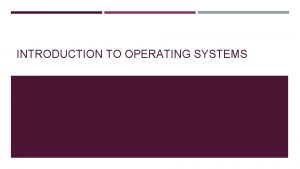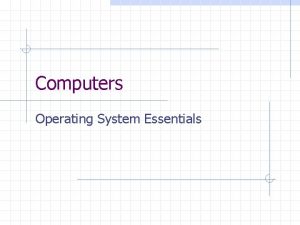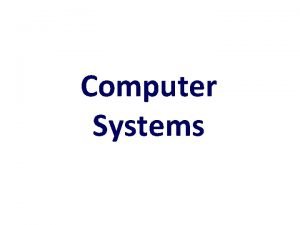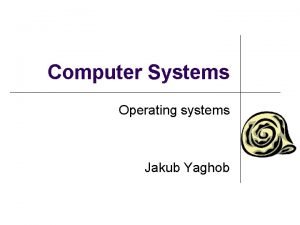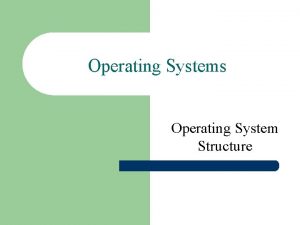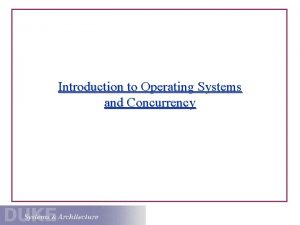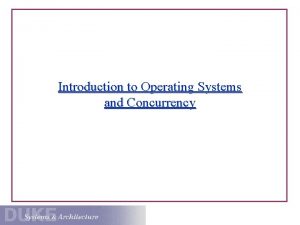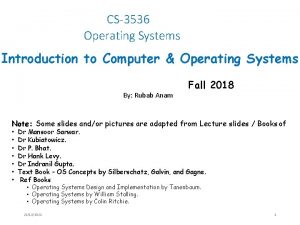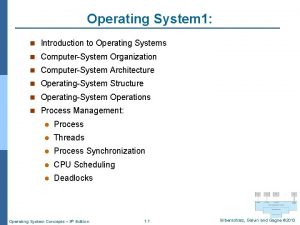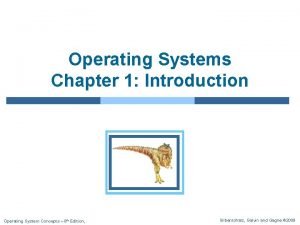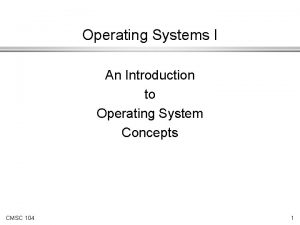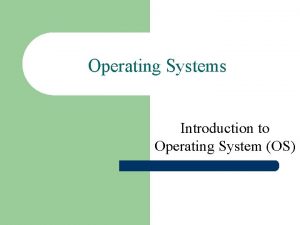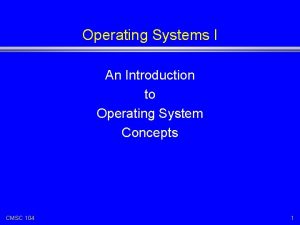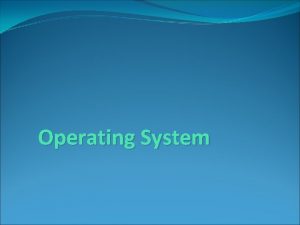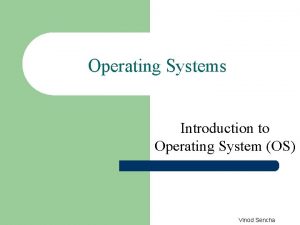Operating Systems Introduction to Operating System OS A











































- Slides: 43

Operating Systems Introduction to Operating System (OS) A. Frank - P. Weisberg

Slides Credits for all PPTs of OS course • The slides/diagrams in this course are an adaptation, combination, and enhancement of material from the following resources and persons: 1. Slides of A. Silberschatz, P. B. Galvin and G. Gagne (see book references ahead) with some enhancements by Y. Wiseman. 2. Slides of Mario Marchand of the University of Ottawa and Patricia Roy of Manatee Community College based on W. Stallings (see book reference ahead) with some enhancements by O. Kremien and E. Gruengard. 3. Some diagrams from R. A. Finkel and Andrew S. Tanenbaum (see book references ahead). 2 A. Frank - P. Weisberg

Initial Objectives 3 • To describe the basic organization of computer systems and operating systems. • To give an overview of the many types of computing environments. • To explore varied types of operating systems. • To provide a grand tour of the major components of operating systems. • To describe the services an operating system provides to users, processes, and other systems. • To discuss the various ways of structuring an operating A. Frank - P. Weisberg system.

What is an Operating System (1)? • A modern computer consists of: Ø One or more processors Ø Main memory Ø Disks Ø Printers Ø Various input/output devices. • 4 Managing all these varied components requires a layer of software – the Operating System (OS). A. Frank - P. Weisberg

What is an Operating System (2)? • An Operating System is a program that acts as an intermediary/interface between a user of a computer and the computer hardware. • OS goals: – Control/execute user/application programs. – Make the computer system convenient to use. – Ease the solving of user problems. – Use the computer hardware in an efficient manner. 5 A. Frank - P. Weisberg

Where does the OS fit in? 6 A. Frank - P. Weisberg

Services provided by an OS • Facilities for program creation – editors, compilers, linkers, debuggers, etc. • Program execution – loading in memory, I/O and file initialization. • Access to I/O and files – deals with the specifics of I/O and file formats. • System access 7 – resolves conflicts for resource contention. – protection in access to resources and data. A. Frank - P. Weisberg

Why are Operating Systems Important? • Important to understand know how to correctly use when writing user applications. • Large and complex systems that have a high economic impact and result in interesting problems of management. • Few actually involved in OS design and implementation but nevertheless many general techniques to be learned and applied. • Combines concepts from many other areas of Computer Science: Architecture, Languages, Data Structures, Algorithms, etc. 8 A. Frank - P. Weisberg

Course Syllabus (1) • Motivation for Operating Systems (OS) • Introduction – What's an Operating System? – Computer/Operating System Overview – Evolution of Operating Systems – Functional/Protection Aspects – Operating System Structures 9 A. Frank - P. Weisberg

Course Syllabus (2) • Concurrent Processes – Process Models and Management – Process Description and Control – Task/Thread Description and Control – Concurrency: Mutual Exclusion and Synchronization – Concurrency: Deadlock and Starvation 10 A. Frank - P. Weisberg

Course Syllabus (3) • Memory Management – Real Memory Management – Motivation for Virtual Memory (VM) – Paging and Segmentation – Page Fetch, Placement and Replacement 11 A. Frank - P. Weisberg

Course Syllabus (4) • Uniprocessor Scheduling – Levels of CPU Scheduling – Process Scheduling • External Storage Management – File Systems/Management – Directories – File Allocation – Disk Scheduling 12 A. Frank - P. Weisberg

Main Bibliography A. Silberschatz, P. B. Galvin, and G. Gagne, “Operating Systems Concepts (Essentials)”, 9 th Edition, John Wiley & Sons, 2012. http: //codex. cs. yale. edu/avi/os-book/ 13 A. Frank - P. Weisberg

Main Bibliography 14 W. Stallings, “Operating Systems: Internals and Design Principles”, 8 th ed, Pearson, 2015. http: //williamstalli ngs. com/Operating Systems/ A. Frank - P. Weisberg

Main Bibliography A. S. Tanenbaum, “Modern Operating Systems”, 4 th ed, Pearson, 2015. 15 http: //www. pearsonhigh ered. com/educator/acad emic/product/0, , 013600 6639, 00%2 ben. USS_01 DBC. html A. Frank - P. Weisberg

Main Bibliography 16 T. W. Doeppner, Operating Systems in Depth, John Wiley & Sons, 2011, http: //eu. wiley. com/ Wiley. CDA/Wiley. Ti tle/product. Cd. EHEP 001803. html A. Frank - P. Weisberg

Computer Hardware Organization 17 A. Frank - P. Weisberg

Computer System Components 1. Hardware – provides basic computing resources (CPU, Memory, I/O devices, Communication). 2. Operating System – controls and coordinates use of the hardware among various application programs for various users. 3. System & Application Programs – ways in which the system resources are used to solve computing problems of the users (Word processors, Compilers, Web browsers, Database systems, Video games). 4. Users – (People, Machines, other computers). 18 A. Frank - P. Weisberg

Hierarchical view of computer system 19 A. Frank - P. Weisberg

Static View of System Components 20 A. Frank - P. Weisberg

Dynamic View of System Components 21 A. Frank - P. Weisberg

Layers of a Computer System End User Application Programs Utilities Operating-System Computer Hardware 22 A. Frank - P. Weisberg Programmer Operating. System Designer

What Operating Systems Do • Depends on the point of view. • Users want convenience, ease of use and good performance – Don’t care about resource utilization. • But a shared computer such as mainframe or minicomputer must keep all users happy. • Users of dedicate systems such as workstations have dedicated resources but frequently use shared resources from servers. • Handheld computers are resource poor, optimized for usability and battery life. • Some computers have little or no user interface, such as embedded computers in devices and automobiles. 23 A. Frank - P. Weisberg

Views of an Operating System • There are three classical views (in literature): 1. Resource Manager – manages and allocates resources. 2. Control program – controls the execution of user programs and operations of I/O devices. 3. Command Executer – Provides an environment for running user commands. • 24 But one more modern view: the Operating System as a Virtual Machine. A. Frank - P. Weisberg

1. Resource Manager • Resource Manager: – Manages and protects multiple computer resources: CPU, Processes, Internal/External memory, Tasks, Applications, Users, Communication channels, etc… – Handles and allocates resources to multiple users or multiple programs running at the same time and space (e. g. , processor time, memory, I/O devices). – Decides between conflicting requests for efficient and fair resource use (e. g. , maximize throughput, minimize response time). • Sort of a bottom-up view. 25 A. Frank - P. Weisberg

OS as a Resource Manager 26 A. Frank - P. Weisberg

Resource Manager oriented OS names • DEC RSX – Resource Sharing e. Xecutive • MIT Multics – MULTiplexed Information and Computing Services • IBM MFT/MVT – Multiple Fixed/Variable Tasks • IBM MVS – Multiple Virtual Storage • DEC VMS – Virtual Memory System • MVS TSO – Time Sharing Option • CTSS – Compatible Time Sharing System • IBM VM – Virtual machine 27 A. Frank - P. Weisberg

2. Control Program • Control Program: – Manages all the components of a complex computer system in an integrated manner. – Controls the execution of user programs and I/O devices to prevent errors and improper use of computer resources. – Looks over and protects the computer: Monitor, Supervisor, Executive, Controller, Master, Coordinator …. • Sort of a black box view. 28 A. Frank - P. Weisberg

Control program oriented OS names • • • 29 Unisys MCP – Master Control Program DR CP/M – Control Program/Microcomputer IBM VM/CP – VM Control Program IBM AIX – Advanced Interactive e. Xecutive DEC RSX – Resource Sharing e. Xecutive A. Frank - P. Weisberg

3. Command Executer • Command Executer: – Interfaces between the users and machine. – Supplies services/utilities to users. – Provides the users with a convenient CLI (Command Language Interface), also called a Shell (in UNIX), for entering the user commands. • Sort of a top-down view. 30 A. Frank - P. Weisberg

Command Executer oriented OS names • IBM AIX – Advanced Interactive Executive • IBM VM/CMS – Conversational monitor System 31 A. Frank - P. Weisberg

Modern view: Virtual Machine (1) • Operating System as a Virtual Machine: – An interface between the user and hardware that hides the details of the hardware (e. g. , I/O). – Constructs higher-level (virtual) resources out of lower-level (physical) resources (e. g. , files). – Definition: OS is a collection of software enhancements, executed on the bare hardware, culminating in a high-level virtual machine that serves as an advanced programming environment. • virtual machine = software enhancement = extended machine = abstract machine = layer = level = ring. 32 A. Frank - P. Weisberg

Modern view: Virtual Machine (2) 33 A. Frank - P. Weisberg

Definition of Operating System • There is no universally accepted definition. • “Everything a vendor ships when you order an operating system” is good approximation but varies widely. • “The one program running at all times on the computer” is the Kernel. • Everything else is either a system program (ships with the operating system) or an application program. 34 A. Frank - P. Weisberg

One Kernel Point of View 35 A. Frank - P. Weisberg

What is the OS/Kernel? • Is the Operating System just the Kernel (not the utilities and application programs)? ! • The Command Line Interface (CLI) (or command layer/interpreter or shell) allows direct command entry by the user. • The shell used to be in the kernel but now is a (first between equals) utility outside of it: – Easy to change/debug – Many of them (sh, bsh, csh, ksh, tcsh, wsh, bash) – Possible to switch between them (chsh) 36 A. Frank - P. Weisberg

UNIX Shell and Utilities User Utilities Shell Kernel Hardware 37 A. Frank - P. Weisberg

CLI is the User OS Interface CLI allows direct command entry: – Sometimes implemented in kernel, sometimes by systems program. – Sometimes multiple flavors implemented – shells. – Primarily fetches a command from user and executes it. – Sometimes commands built-in, sometimes just names of programs; if the latter, adding new features doesn’t require shell modification. 38 A. Frank - P. Weisberg

Bourne Shell (bsh) 39 A. Frank - P. Weisberg

A very simplified Shell 40 A. Frank - P. Weisberg

UNIX System Layout 41 A. Frank - P. Weisberg

General UNIX Architecture (1) 42 A. Frank - P. Weisberg

General UNIX Architecture (2) Other application programs cpp cc nroff sh who a. out Kernel comp date Hardware we as ld vi ed grep Other application programs 43 A. Frank - P. Weisberg
 Dual mode in os
Dual mode in os Architecture of distributed operating system
Architecture of distributed operating system Where does the os fit in
Where does the os fit in Components of operating systems
Components of operating systems Oses definition computer
Oses definition computer Classification of distributed system
Classification of distributed system Dos internal and external commands
Dos internal and external commands Os
Os Sic programming examples
Sic programming examples Buddy system in os
Buddy system in os File system in operating system
File system in operating system Ufs4.0
Ufs4.0 File system in operating system
File system in operating system Examples operating system
Examples operating system Evolution of operating systems
Evolution of operating systems Components of an operating system
Components of an operating system Wsn operating systems
Wsn operating systems Operating systems 3 easy pieces
Operating systems 3 easy pieces Operating systems lab
Operating systems lab Modern operating systems by andrew tanenbaum
Modern operating systems by andrew tanenbaum Components of operating systems
Components of operating systems Design issues in distributed system
Design issues in distributed system Early operating systems
Early operating systems Real-time operating systems
Real-time operating systems Can we make operating systems reliable and secure
Can we make operating systems reliable and secure Alternative operating systems
Alternative operating systems Mit operating system
Mit operating system Operating system internals and design principles
Operating system internals and design principles Evolution of operating systems
Evolution of operating systems Network operating systems examples
Network operating systems examples Visual studio 2005 team suite
Visual studio 2005 team suite Hobby os
Hobby os Embedded systems characteristics
Embedded systems characteristics Operating systems concepts
Operating systems concepts Operating system chapter 1 notes
Operating system chapter 1 notes Layers of operating system
Layers of operating system Computer software is divided into
Computer software is divided into Structure of an operating system
Structure of an operating system Components of os
Components of os Module 4 operating systems and file management
Module 4 operating systems and file management Modern operating systems 3rd edition
Modern operating systems 3rd edition Uc berkeley operating systems
Uc berkeley operating systems Operating systems
Operating systems Improving the reliability of commodity operating systems
Improving the reliability of commodity operating systems

